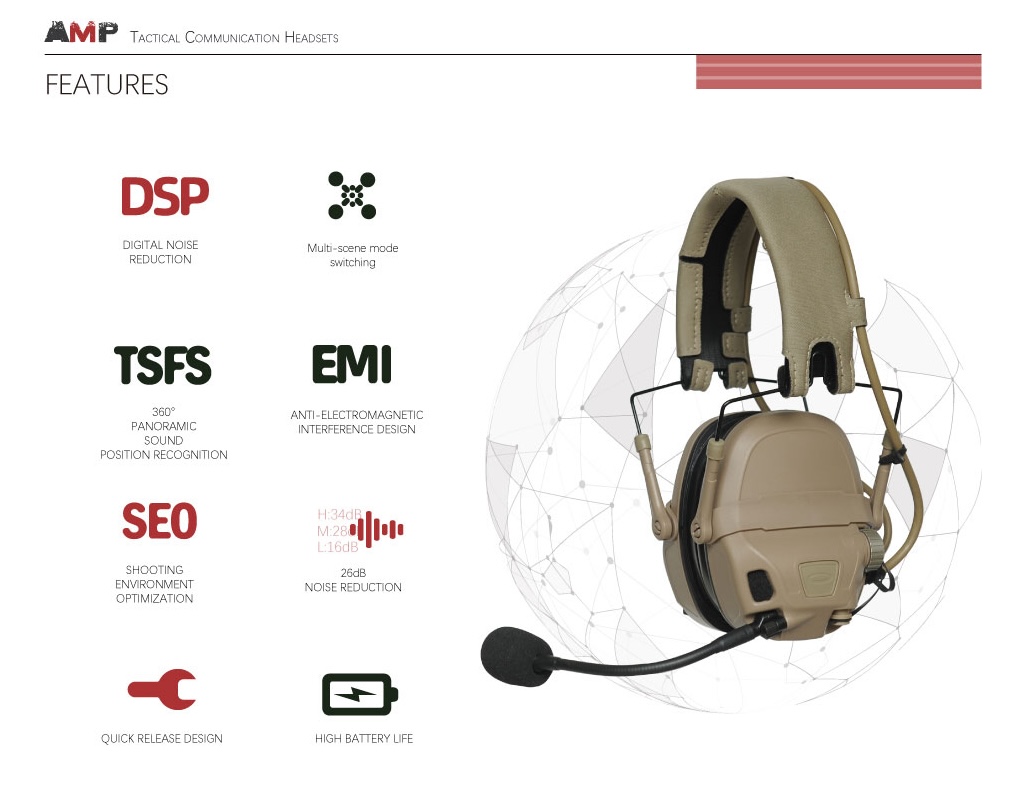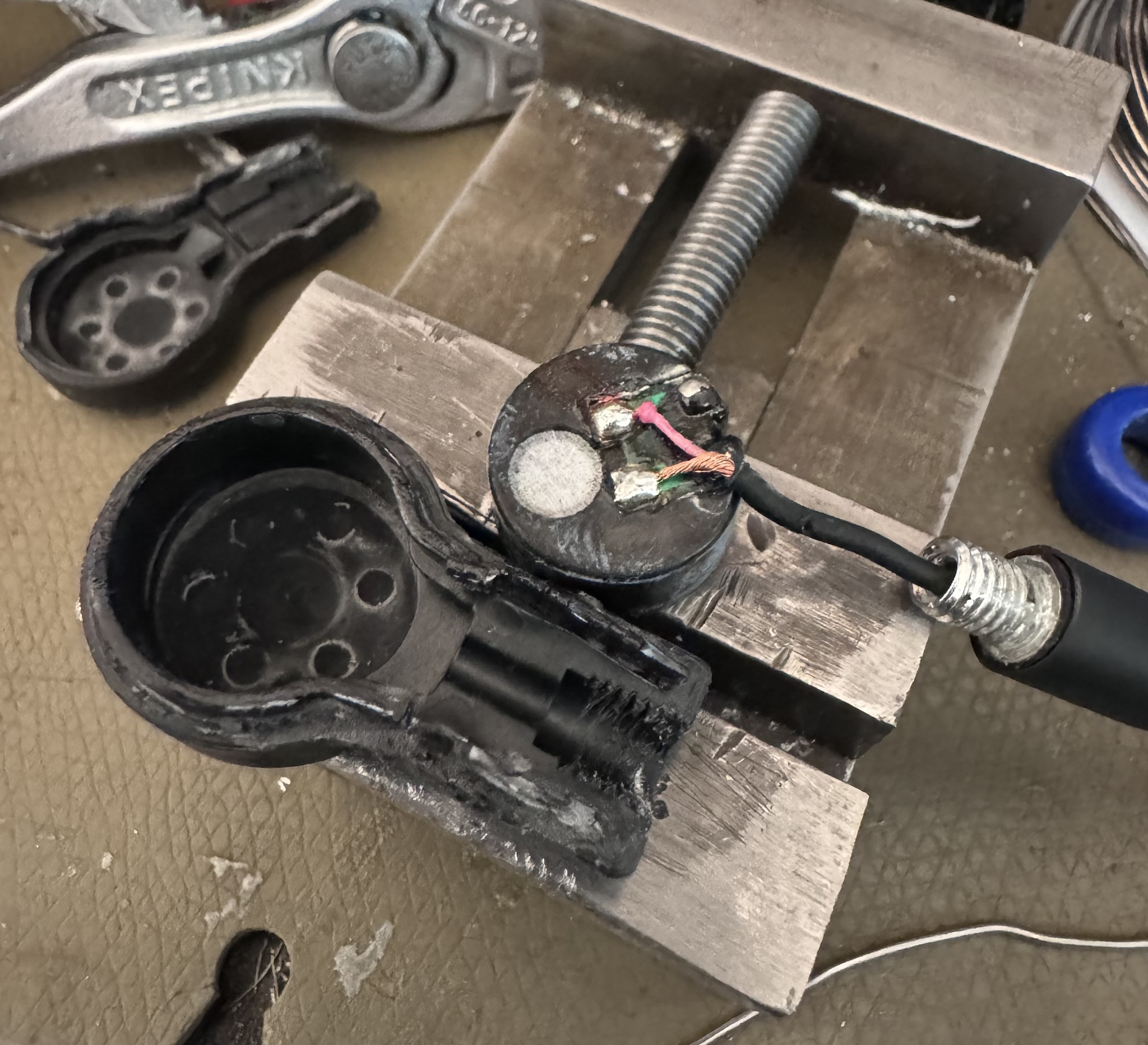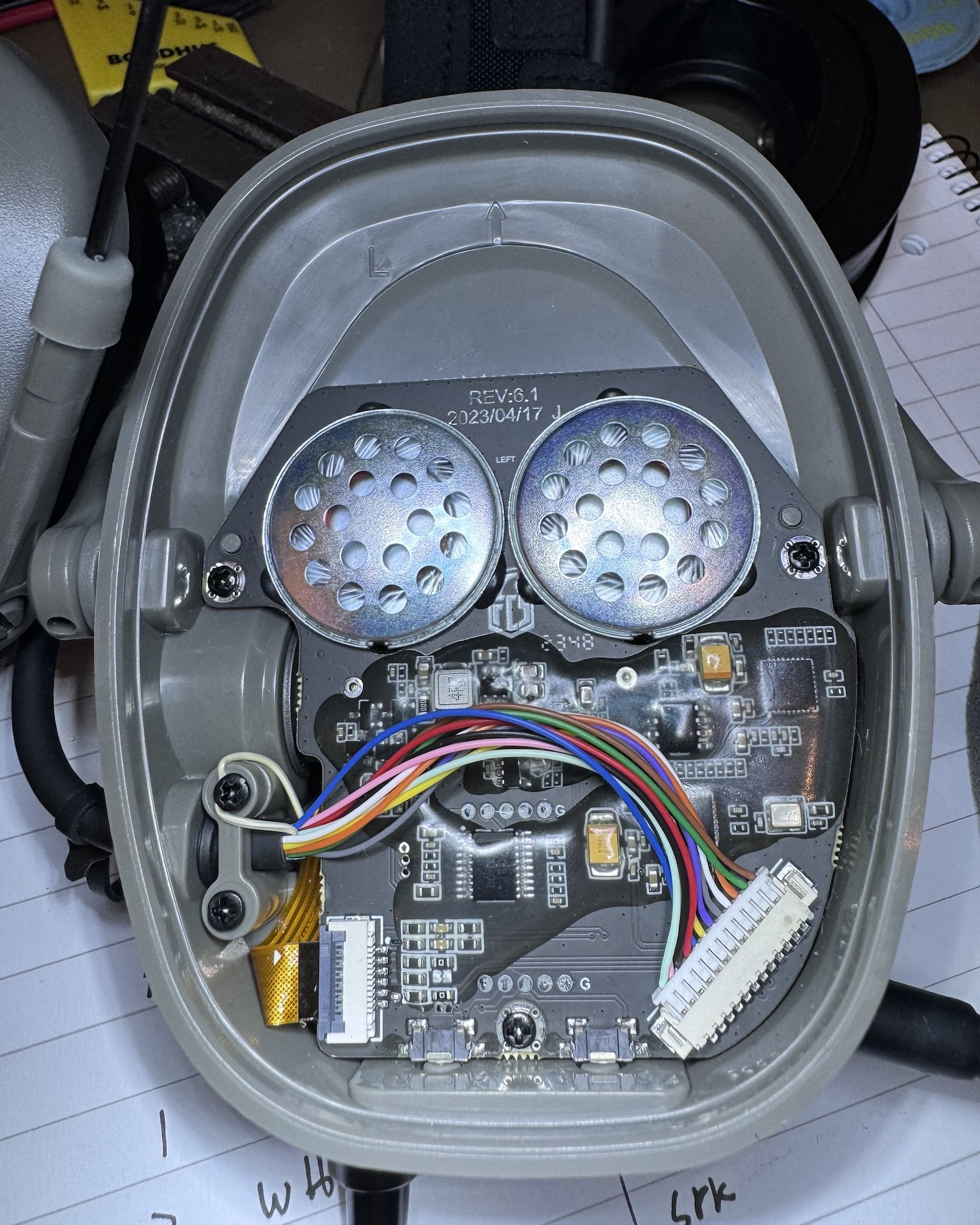FCS AMP Headset — Technical Details

The FCS AMP headset is a tactical communications headset made by Chinese manufacturer FCS. It appears to be heavily inspired by the Gentex AMP series of military headsets.
Table of Contents
Headset Overview
The headset is very much inspired by the Gentex AMP series as mentioned in the intro. Unlike many products of the type, FCS actually has an English language website that does provide a fair bit of information on what you're buying.
The headsets big feature over e.g. a Peltor SportTac or a used ComTac is that this one can do stereo audio for radio comms. It also includes separate speaker elements for talk-through and radio-comms. This ensures that you can still use comms without powering the headset talk-through mode, even if no batteries are installed.

The product page boasts about a variety of features, I'll try to cover if these are realistic below.
System
FCS also offers a fairly complete package, including a PRC-152 clone, a variety of PTT boxes (where I have a V-60, mainly due to a supplier mixup — I had ordered a MPU5 PTT), and a set of downlead cables. They also offer a standalone bluetooth module that can be wired into e.g. a V-60 PTT.
Signal Processing
Foreshadowing, I believe the DSP claim is quite accurate.
The "Multi-scene mode switching" is limited to an indoor/outdoor mode, and they don't explain what this does. From what I can tell the indoor mode is more sensitive to loud noises, i.e. cuts the audio for lower impulse levels.
EMI
The EMI resistance seems to be relatively good — keying a hand held 5 W FM radio near the headset I can hear some DC shift, but nothing that would be noticeable. Keying a 5 W DMR radio did cause some low level noise pickup, low enough that this would not be objectionable.
Passive Noise Reduction
Noise reduction performance seems acceptable, similar to wearing a Peltor SportTac.
Power
The headset runs off two AAA batteries, and by default will only work reliably with Alkaline batteries, see Issues section.
High battery life is subjective, I did a rough measurement of current draw, and it seems to be less than 10 mA from the series connected AAA batteries, peaking to ~30 mA. Energizer L92 (Lithium) AAA's have a capacity of around 1200 mAh; at room temperature and currents less than ~50 mA an alkaline battery will have the same capacity.
We can estimate a battery runtime of 40-120 hours depending on volume levels. Use at lower temperatures will degrade runtime with alkaline cells.
Comfort
Comfort-wise, the headset is equivalent to the SportTac, the design over all is very similar. It also has some voice recordings that play to tell you the current mode and when powering on/off, this can be easily switched between English and Chinese.
Frankly it's hard to tell which headset I'm using unless they're powered on.
Speaker/TT Quality
Talk-through sound quality is pretty good, as long as you leave the volume fairly low. The lowest setting is very quiet, the second lowest is the closest to equal levels you can get. I would have liked to see a few more volume control steps, since each increment increases gain by a lot.
Noise levels in the speaker amplifiers are good, and decent microphones seem to have been used. The internal speakers seem to be fairly good when powered by my V60 DSP mod (future article).
Microphone Quality
The boom microphone is nicely built, but it's a generic electret capsule with set dressing. The audio quality IMO was poor, with high distortion, poor treble, and little to no background noise canceling. It seemed to be extremely sensitive, probably more sensitive than the specified level.
Background noise was significantly more audible than with a noise canceling dynamic microphone (compared with a Peltor MT31 or equivalent dynamic mic).
There is an option to buy a replacement dynamic microphone, I note that at ~$40 this is an expensive add-on to an already relatively expensive package.
The dynamic microphone measures 150 Ω at DC, and looks fine mechanically. Sound-wise it's very different to the Peltor reference and not in a good way. It is also not waterproof, but probably usable in rain for some time without major issue.
It is quite sensitive and has extremely poor frequency response, requiring at least a 10 dB boost at 2 kHz. I believe it also has poor directivity, and I had severe issues with oscillation even at moderate talk-through gains. In conclusion, cheap microphones are terrible.

For my actual use of this system, I kitbashed a Gentex made dynamic microphone onto the boom/plug of the AMP knockoff mic. This required some minor surgery to get the old Gentex assembly apart, and a bit of epoxy to get everything in place again.
In the box
My kit included the headset with standard overhead strap, a set of helmet mounts, a bag full of spare velcro pads for helmet cable mounting, some O-rings and silicone cable ties, and a U-174 (mono, the 4-pin ¼" jack) downlead.
I would have liked to see a stereo-capable downlead included in the kit, this is an optional extra that is not included with either the V-60 or the AMP headset.
I also purchased the optional gel earmuffs. I saw some online posts saying these were now standard, but my set came with foam muffs. Installation was quite easy, but make sure to pay attention to the orientation. The gel pads have a little vent hole that should go on the bottom.
Teardown
The headset is very easily torn down, just pull off the earmuffs and remove the foam.
As seen below, the board revision is 6.1 from April 2023. This is a curiously high number, suggesting they've been improving/revising the design for some time. The production batch for the PCB seems to be week 48 2023, suggesting that the 6.1 revision was relatively successful.

Above is a picture of the left side PCB. This contains all the smarts. We can see two internal speakers, where one is used for talk-through and the other is directly connected to the external Mini-XLR plug (floating). Those are glued to the PCB, with the magnet poking through and soldered on the back, a neat way of mounting it.
The speaker DC impedance measures out as 32 Ω.
The flex-connector plugs onto the Mini-XLR plug, and the large JST connector runs over to the right side PCB. The right side PCB is not interesting, being purely a wiring routing board. The headset can be used with both the Mini-XLR and the boom microphone connected to either the left or right side.
Ambient microphones and boom microphone connect on the back of the board with connectors, and the battery power is supplied through pogo-pins on the back.
FCS chose to order custom lasered parts, making identification harder than it would otherwise be. I'm not sure what the DSP is, but the TSSOP chip in the middle is probably an STM32F030 or a similar Gigadevices part. If I had to guess, the DSP could be an ADAU1767, but I haven't checked the pinout.
Not sure what the switching power supply is doing there, doesn't seem like it would be necessary. It is definitely used though.
In the power-on state, the current consumption goes down for increasing battery voltage. I wonder if the MCU is powered directly off the battery and powers on the switching supply and DSP circuitry on demand, this could explain the issues with higher than 3.3 V supplies (see below).
The external connections use ferrite and capacitive filtering, the microphone lines also seem to use 4-terminal feed-through capacitors.
They also elected to use a hard potting compound over all the passive components. This is not a bad idea for a headset intended for outdoor use (and being inside the ear-cups, they will be in a high humidity environment!). It also has the benefit (for them) of making reverse engineering harder.
Build quality is in line with expectations given the price, no issues.
Pinout
This pinout was determined by measurements. The headset uses a 6-pin Mini-XLR that can be plugged into either the left or right earcup. The FFC pinout is made relative to the marking on the PCB (at the top, counting towards the bottom).
| Mini-XLR Pin | FFC | Function | Comment |
| 1 | 5 | No-connect | Goes to a loose pad on the board |
| 2 | 4 | Speaker Left | 32 Ω |
| 3 | 3 | Speaker Common | Floating vs. HS circuitry |
| 4 | 2 | Speaker Right | 32 Ω |
| 5 | 1 | Mic– | |
| 6 | 6 | Mic+ | Standard is electret microphone |
The use of separate isolated ground returns for speakers and microphone is good practice especially for duplex-capable system.
Issues/Improvements
Here are my complaints:
Battery Power System
I would have liked to see an option to use rechargeable batteries instead.
The biggest power issue is that the AAA's are series connected directly to the 3.3 V supply line for at least the MCU. This is fine for alkalines, which at most float at 1.6 V.
However, when installing brand new Lithium AAA primary cells, the open circuit voltage is up to 1.8 V. The voltage drops quickly for 1.5-1.6 V, but when the 3.6 V Lithium voltage is applied, the MCU fails to start.
I modified the right-side board, cutting the battery trace and installing a TLV700 series 3.3 V regulator. This is a fairly low Iq (~30 µA) linear regulator that seems to operate fine in dropout, and it's strange that this issue made it to production.
The headset circuitry only operates down to around 2.2 V (effective range 2.2-3.4 V), and will not power on at 2.1 V. This will leave a fairly large amount of Alkaline battery charge left when it cuts out.
The issue is lessened for Lithium primary cells which conk out around 1.4-1.5 V per cell, but without modifications you'd have to pre-drain a few % of charge from these batteries prior to use.
External Power
I would have liked to see an option for powering the headset externally from the V60. There may be an easy way to do this, but it looks to me like the only unused Mini-XLR pin is number 1, which is not connected to anything on the PCB.
The use for this feature would be that the external radio could power the headset in talk-through mode, saving the internal batteries for standalone use.
Potential Improvements
I may redesign my own electronics for this headset. The main improvements that could be made IMO would be:
- Rechargeable battery with power from the radio, or at least an external power input
- Requires a wide-range power input, preferably 4.5-15 V range to cover all reasonable hookups. This is very much doable.
- AAA size li-ion batteries (10440 size) are rated for 350 mAh or around 1.3 Wh for a total of 2.6 Wh.
- A set of lithium AAA primary cells have a capacity of around 3.6 Wh (1.5 V per cell at 1200 mAh), so the runtime would be less but with radio-charging it would be fine.
- Putting a Li-Po pack in the right earcup could significantly improve the battery capacity.
- Should come with a dynamic microphone, the stock electret one is not good.
- Quality of the FCS dynamic mic: not recommended, try to find a Gentex or Peltor one.
- Acoustic noise canceling equivalent to the RA-5000 would be super slick.
- Easily available options seem to be slim since e.g. the Qualcomm chips that support ANC require license keys to activate these features in the firmware
- Using a DSP to implement the feature myself would probably require adding additional internal microphones.
- With a rechargeable battery in there, Bluetooth support could be added which would also be cool
Future Work
I will likely update this article in future, when I have completed by redesign of the V-60 PTT. This redesign will basically be a compact more integrated version of the RF-5980 mod capabilities (indeed, the RF-5980 project functioned as a proof of concept for the V-60 project).